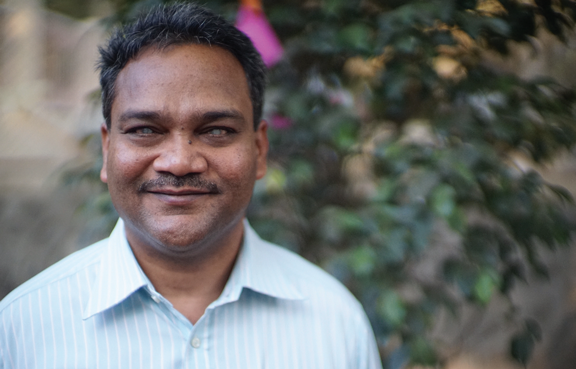
Profession: Professor of the Pali language
Age: 43
Location: Pune, India
Where are you from originally? I was born in the state of Maharashtra, was raised in Mumbai, and then shifted to Pune for graduate school.
What spiritual tradition were you raised in? A liberal Hindu one.
Are you a Buddhist? Yes, I consider myself a Buddhist, as do my wife and children. However, we are not affiliated with any particular sect.
How did you first get interested in the dharma as a profession? I have two master’s degrees, one in Sanskrit and a second in Pali, the language of the historical Budddha. While pursuing my degrees, I was very impressed by the Pali language and literature, and the Buddhist philosophical ideas found in the Milindapanha (“The Questions of King Milinda”) inspired me to study the dharma.
Which spiritual guides or teachers inspire you? Initially, I was inspired by the meditation master S. N. Goenka. Later I encountered other teachers, including Ven. Dhammadipa of the Czech Republic, Ven. Samdhong Rinpoche, Ven. Sangharakshita of the UK, Ven. Nyanissara of Myanmar, and recently Dzongsar Khyentse Rinpoche and Jetsunma Tenzin Palmo.
What dharma books do you like to read? I love to read original Buddhist scriptures in Pali and Sanskrit, primarily the Pali Nikayas and the Sanskrit works of Ashvaghosha and Shantideva.
Are there many dharma books in Braille? How are you able to access these books as a blind person? Unfortunately, there is not a single dharma book available in Braille in India. In the past I depended on readers and audio recordings of these books. These days I try to access secondary material about Buddhism online by using screen reader software.
Do you think Buddhism is growing in India? If so, why? Yes, certainly, but there is no single answer to the question “why?” Different people come to Buddhism with different expectations. They find something in it that helps them to live their life in a better way. In India, the early interest in Buddhism was academic. Later, some individuals who were unsatisfied with Hinduism became interested out of their personal quest for a meaningful religious life. Some formally converted to Buddhism; others, however, didn’t think formal refuge was necessary—they considered Buddhism to be a higher or advanced form of Hinduism. And then there were the people of oppressed classes (the so-called Dalits), who were victims of social inequality because of Hindu society’s caste system: they were attracted to the Buddhist social message of freedom, equality, fraternity, and justice.
Today there are mainly two types of Indians coming to Buddhism: those who seek spiritual liberation through meditative practice and those from the “lower” castes or tribal communities who see a light of hope in their conversion to Buddhism.
Can you speak about this Dalit community? Members of the community prefer to be called “Buddhists” or even “Ambedkarite Buddhists” rather than “Dalits.” In the beginning of the 20th century, many social activists in different parts of India, including Buddhist monks, laid the foundation for the movement of mass conversion to Buddhism that took place in 1956 under the leadership of Dr. B. R. Ambedkar. His followers did not have much understanding of Buddhism initially, but they had great conviction in Dr. Ambedkar. However, 50 years later, with the spread of education and economic stability, the community is now in a position to explore Buddhism through practice and academic study. Many of its members practice vipassana meditation as taught by S. N. Goenka.
I find great enthusiasm in this community to study and understand Buddhism and to make it a part of day-to-day life. Buddhism is not only transforming individual lives but also empowering the community as a whole. And I am happy that through my profession I am a part of this positive process, which also strengthens my own faith in the Buddha’s teachings.